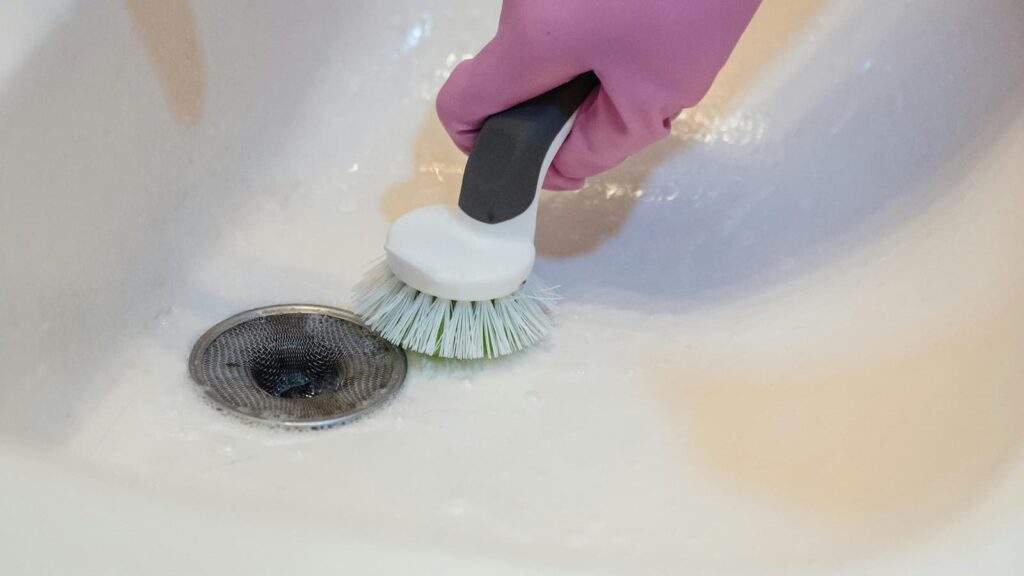Gas Leak: Why It Happens and What to Do
Gas leaks are a serious safety hazard that can lead to devastating consequences if not addressed promptly. From explosions and fires to health complications…

If you’ve spent hours cleaning the kitchen and bathroom but still notice an unpleasant odor, the culprit could be lurking in your sink drain. Getting rid of a stinky sink drain often requires a process of elimination, starting with some simple home remedies.
Fortunately, there are effective solutions to combat these issues and restore the fresh, clean smell to your sink. These include the baking soda and vinegar method, using boiling water, cleaning the sink aerator, cleaning the garbage disposal, and cleaning the P-trap. By addressing the root causes, you can effectively eliminate foul odors and maintain a pleasant, fresh-smelling sink.
Sinks are notorious for developing unpleasant smells because various things can go wrong inside the pipes. Some of the most common causes of a stinky sink drain include:
Before tackling that smelly sink drain, make sure you have the right tools and equipment on hand. Here’s what you’ll need:
Having these items readily available will ensure a smooth and efficient drain-cleaning process.
Now that you’ve gathered the necessary tools, let’s explore some effective tips and remedies how to get rid of smelly sink drain:
The classic baking soda and vinegar method is one of the most popular and effective DIY solutions for a smelly sink drain. Here’s how it works:
This simple yet powerful combination helps to deodorize and clear out your sink drain, effectively removing the source of the odor.
Pouring boiling water down a smelly sink drain can also effectively clear out built-up grime and grease. The heat helps to melt and dislodge stubborn deposits, flushing them down the drain.
Be cautious when handling boiling water, and consider wearing heat-resistant gloves for added safety.
The sink aerator, the small screen-like attachment at the end of your faucet, can also contribute to a smelly drain if it becomes clogged with debris. Over time, this aerator can accumulate mineral deposits, hair, and other gunk, which can lead to unpleasant odors.
To clean the sink aerator:
This simple maintenance step can help improve your sink’s overall drainage and airflow, reducing the likelihood of foul odors.
If you have a garbage disposal installed in your sink, it’s important to keep it clean and well-maintained to prevent unpleasant smells. Over time, food particles and grease can accumulate in the disposal, leading to bacterial growth and odors.
To clean your garbage disposal:
Regular cleaning and maintenance of your garbage disposal can go a long way in preventing and eliminating foul smells.
The P-trap is the curved section of pipe underneath your sink that helps to prevent sewer gases from entering your home. Over time, this area can accumulate debris and become a breeding ground for bacteria, leading to unpleasant odors.
To clean the P-trap:
Keeping your P-trap clean and in good working order can help eliminate sewer gas odors and maintain a fresh-smelling sink.
It’s important to take proactive steps to prevent future odors from returning. Here are some tips to keep your drains fresh and odor-free:
If the DIY methods don’t seem to be doing the trick, or if you’re dealing with a particularly stubborn or recurring smelly drain issue, it may be time to call in a professional drain cleaning service.
TaskPro offers expert drain cleaning services to homeowners and businesses in the area. Our licensed and experienced plumbers use modern equipment and techniques to thoroughly clean and clear your drains, addressing the root cause of any odor problems.
With 24/7 emergency services and affordable pricing, TaskPro is your go-to solution for tackling those stubborn, smelly sink drains. Contact us today to schedule an appointment and get your drains fresh and odor-free.
There are several common causes of a smelly sink drain, including food debris buildup, bacterial growth, hair and soap scum accumulation, mineral deposits, sewer gas backflow, and poor ventilation. Identifying the specific issue is the first step in addressing the odor.
One of the most effective natural remedies for a smelly sink drain is baking soda and vinegar. Pour 1/2 cup of baking soda down the drain, followed by 1/2 cup of white vinegar. Let the mixture sit for 10-15 minutes before flushing it out with boiling water.
Yes, baking soda and vinegar are generally safe and effective for cleaning sink drains. The chemical reaction between the two ingredients helps to break down organic matter and clear out debris without damaging your plumbing system.
Share this Guide
Gas leaks are a serious safety hazard that can lead to devastating consequences if not addressed promptly. From explosions and fires to health complications…
Septic tanks are a vital component of wastewater management systems, particularly in areas where municipal sewer systems are unavailable. These underground structures treat and…
Choosing the right toilet for your home is more than a simple decision; it’s an investment in comfort, efficiency, and functionality. The type of…